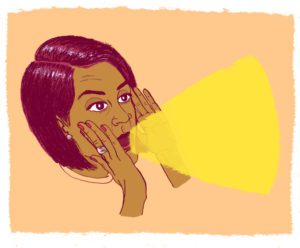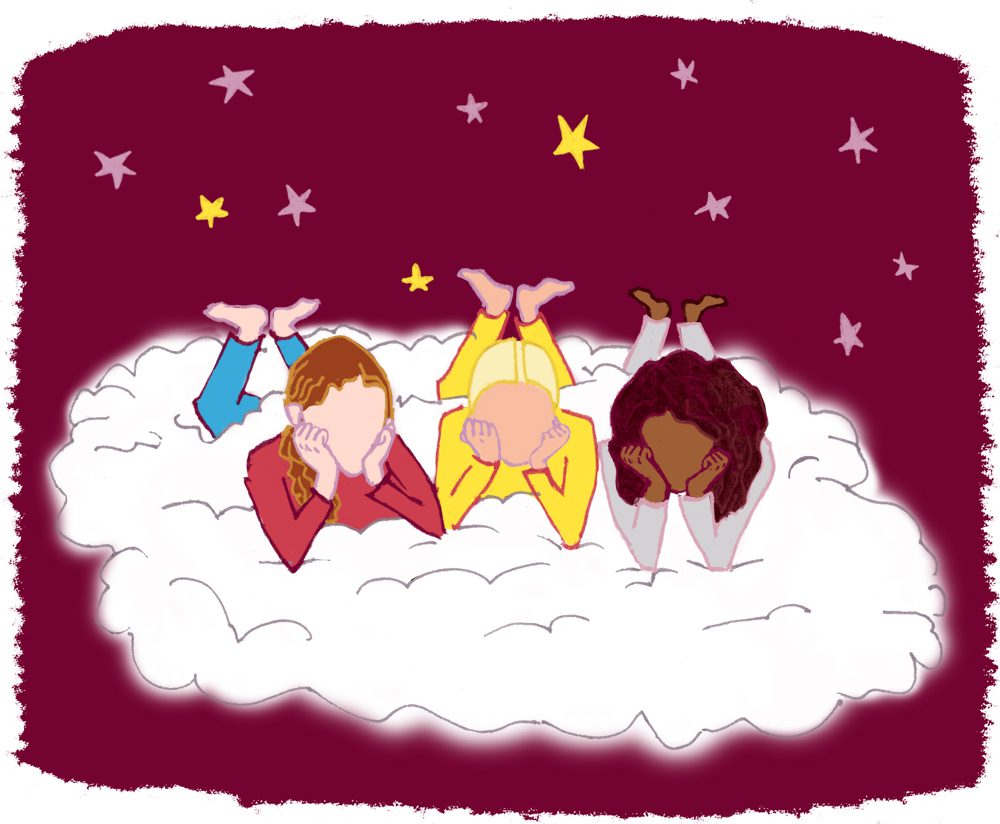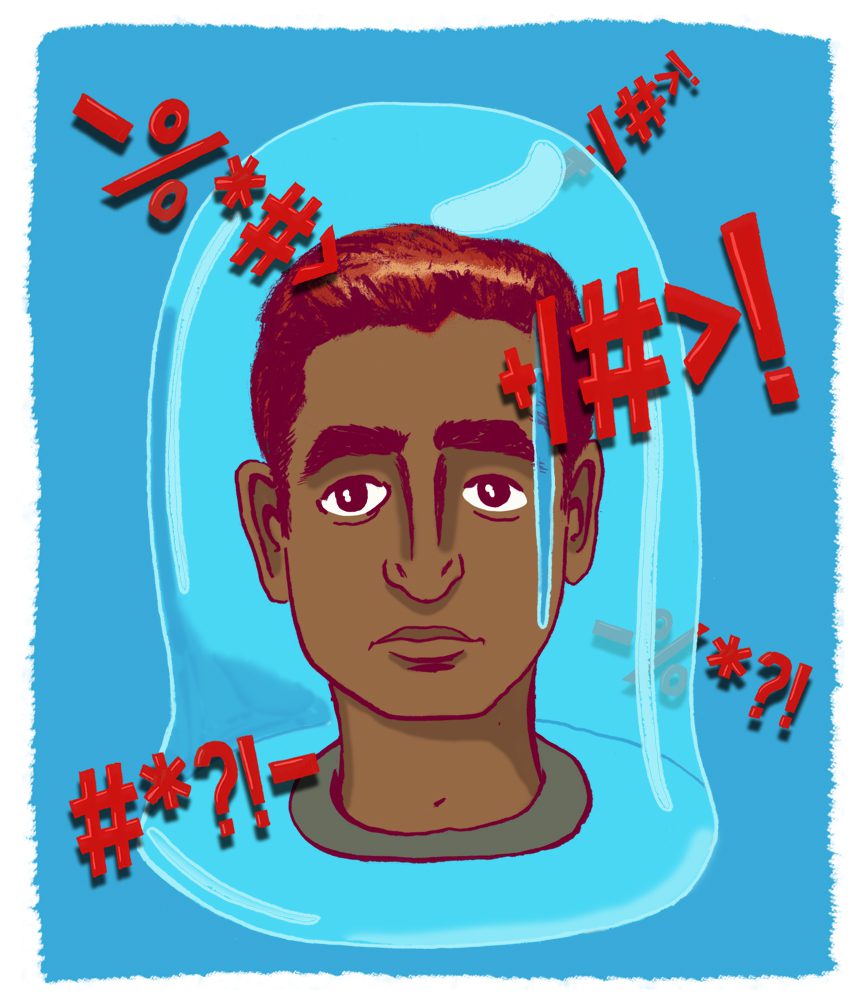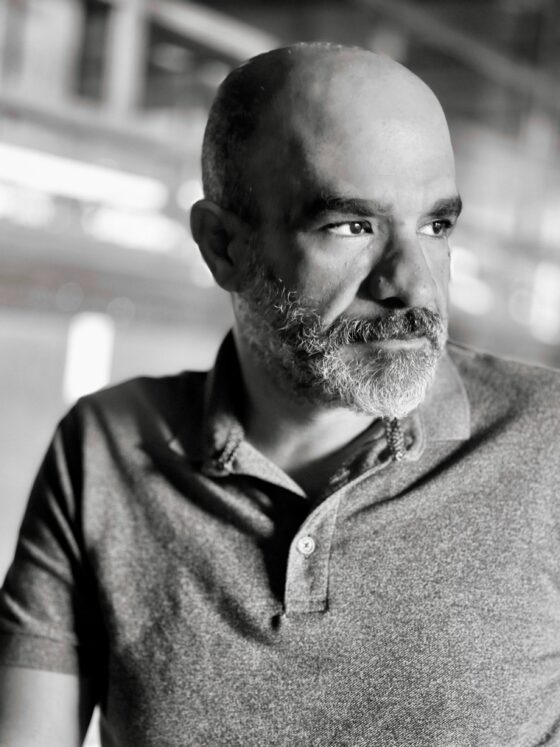
In my fifth-grade year, I wore a bracelet made of shells gifted to me by an older cousin who knew how to navigate American fashion. I was in art class when a girl next to me asked to see it—a girl who had repeatedly commented on my brown skin, later dismissing each comment as a joke. I gave her the bracelet and she held it in her hand for a moment before declaring it hers. When I reached for it, she called me a “sand-nigger,” a term I had never before heard, and one I did not hear again until the days following September 11, 2001, when our national reckoning with brownness kicked up old cultural debris. I can’t fully explain the powerless I felt, except to say that I’m reminded of it when questions follow women’s stories of sexual exploitation, in which the room’s exit is visible yet beyond reach. I could not have explained my inability to reclaim the bracelet, to turn to a teacher for defense, or my decision to hand something I valued to a girl I hardly trusted. Rather than defending myself in the moment, I spoke up afterwards, and never saw the bracelet again.
In the predominantly white towns of 1990s America, where I grew up just a few years ahead of Aziz Ansari, the demographics were shifting. Pressured by the needs of the real estate market, neighborhoods that had built their boundaries through redlining and housing discrimination began to open themselves up to trickles of middle-class immigrants—college-educated and English-speaking, positioned to assimilate into the economic and social life of towns previously defined by waves of white flight. Indian-American pockets of immigration were spread unevenly throughout the country. We were present in numbers, if not in popular media. Enough to be noticed but not enough to trouble the racial dynamics of the white neighborhoods into which we, for the most part, made our homes.
To assimilate in the 1990s required a heightened allegiance to gender norms, an understanding that while brownness could never be erased, one could be doubly feminine or masculine. From this other-world of girlhood, I watched my brother and cousins play street hockey and soccer, memorize the lyrics and chords to …And Justice for All, and settle into a group of friends whose whiteness could shield them from some of the precariousness of racial exclusion, while exposing them to its most vile manifestations.
To be brown in America in the 90s meant a steady diet of racial epithets scratched onto desks, spat out at recess, and hurled across sports fields. When a classmate left a stream of such epithets on my family’s answering machine, I listened to the recording with my brother and cousins. They promptly erased it, telling nobody. To be a boy, it seemed, meant to be steely in the face of each act of aggression. To disclose emotion meant to compromise hard-earned Americanness by admitting that the insult had happened, and to further violate the code of masculine boyhood by admitting that it had hurt.
My girlhood friendships provided their own padding and their own vulnerability. We spent evenings in each other’s bedrooms disclosing our romantic interests, some within reach and some beyond—all white. I fell into the same pattern. To be non-white was precarious enough without the added liability of another person on the margins. I knew, from my own eavesdropping, that these were girls the Indian boys in my community found attractive—affable, academic, peripherally in their circle of friends, and exclusively white. One attended the prom with my cousin, explaining to the group that they were attending only as friends. In a later conversation, when asked if she would ever date an Indian boy, another friend quietly shrugged, later concluding softly that she wasn’t racist, but that such a decision would have to depend.
Years later, when I found copies of the school literary magazine I had edited, tossed onto a library bookshelf and scribbled with ethnic slurs, I confided in a white friend in whose room I had spent so many adolescent evenings. The conversation was warm, yet superficial, and we disposed of the copy in a recycling bin, never again addressing what had taken place. We did not speak to the deeper issues, the ones that had called into question the full meaning of belonging. But that shared girlhood gave me a temporary relief, an acceptable corridor into which I could retreat and admit that the manifestations of racial aggression were painful. It did not rewrite the terms of my childhood, but it was a balm.
Masculinity, on the other hand, demanded two qualities that brownness rendered impossible: stoicism and romantic prowess. The first-generation American boys with whom I was raised were told implicitly to be emotionless in the face of verbal assaults that tore into their right to live where their families had landed. And mainstream white femininity had not taken into account the possibility of brown boys as real, as people, as romantic prospects. The rewards of assimilation were shifting from a pre-adolescent hope of reprieve from racial antagonism, to a teenage hope for a place in the dating game. Though always evolving, these rewards remained out of reach.
The term intersectionality hadn’t trickled into common parlance, but there was a palpable sense that the bait and switch of assimilation, and the withholding of its last frontier—romantic entanglement—was bred from a similar place from which American racism came. Indian-American kids of my generation understood that our parents rode waves of immigration policy made possible by sweeping battles for racial justice. And we knew that the work was unfinished beyond the borders of our towns, just as it was within. Still, it was shameful to speak publicly about racial epithets. To offer any evidence of this marginalization would have been to admit that we were anything but full citizens. We were scattered across towns and relied on the boundaries of school districts to keep these incidents private.
It was in the context of this environment that Aziz Ansari emerged—unapologetically American in his breaking down of America. His work illustrated the difference between laughing it off and laughing at it—the latter a right earned only by those who had experienced racism first-hand, who had processed it and placed it in the broader context of the country’s search for itself. Unwilling to perform an Indian accent, and furthering discussion of race and power beyond Indian identity, his work finished the conversations I had so meekly started years back. In my childhood, it was a privilege just to play by the rules. Now, with the full visibility of a screen, brown people were rewriting them.
Ansari grew up in South Carolina and I in New Jersey, yet our connected histories precede our time in the United States. Our families come from the same southern Indian state, and our parents were granted admission to the country through the same immigration policies that, in the 1960s, placed heavy emphasis on professional status and family reunification—expanding a demographic whose numbers have doubled in every decade since. Yet nativist views are more easily extracted from policy than culture; Ansari and I grew up in an age in which the professional skills our parents were able to offer as rent gave us lives in the geographic centers, yet still in the social margins.
As brown-skinned Americans, our bodies were often present for conversations we didn’t seek, and our silence was often understood as a sanctioning of beliefs that were at best incomplete, and at worst a violation. The rules of a more even world might call into question those of us who knew that we deserved better but could not match this knowledge with unambiguous demands. But there is no classroom or bedroom walled off from the power dynamics of the world outside of it. Accusations against Ansari serve as a reminder that one’s invisibility in a broader society renders the cues exhibited in private momentarily unnoticeable.
To advance race and gender means to accept, sometimes, a simultaneous gain and loss. But it also means to understand intimately the forces that compel us to comply in silence. During my childhood, when The Simpsons‘s Apu served as our most public voice, there was no image to declare a fundamental humanity either to ourselves or a wider world. Had Ansari’s art been present then, I would have known to raise my voice. I would have known how to distinguish between a gentle nudge and a hard push. I would have known to hold onto what belonged to me, to leave the rooms I sought to and close their doors behind me.
***
Rumpus original art by Stephanie Tartick.







